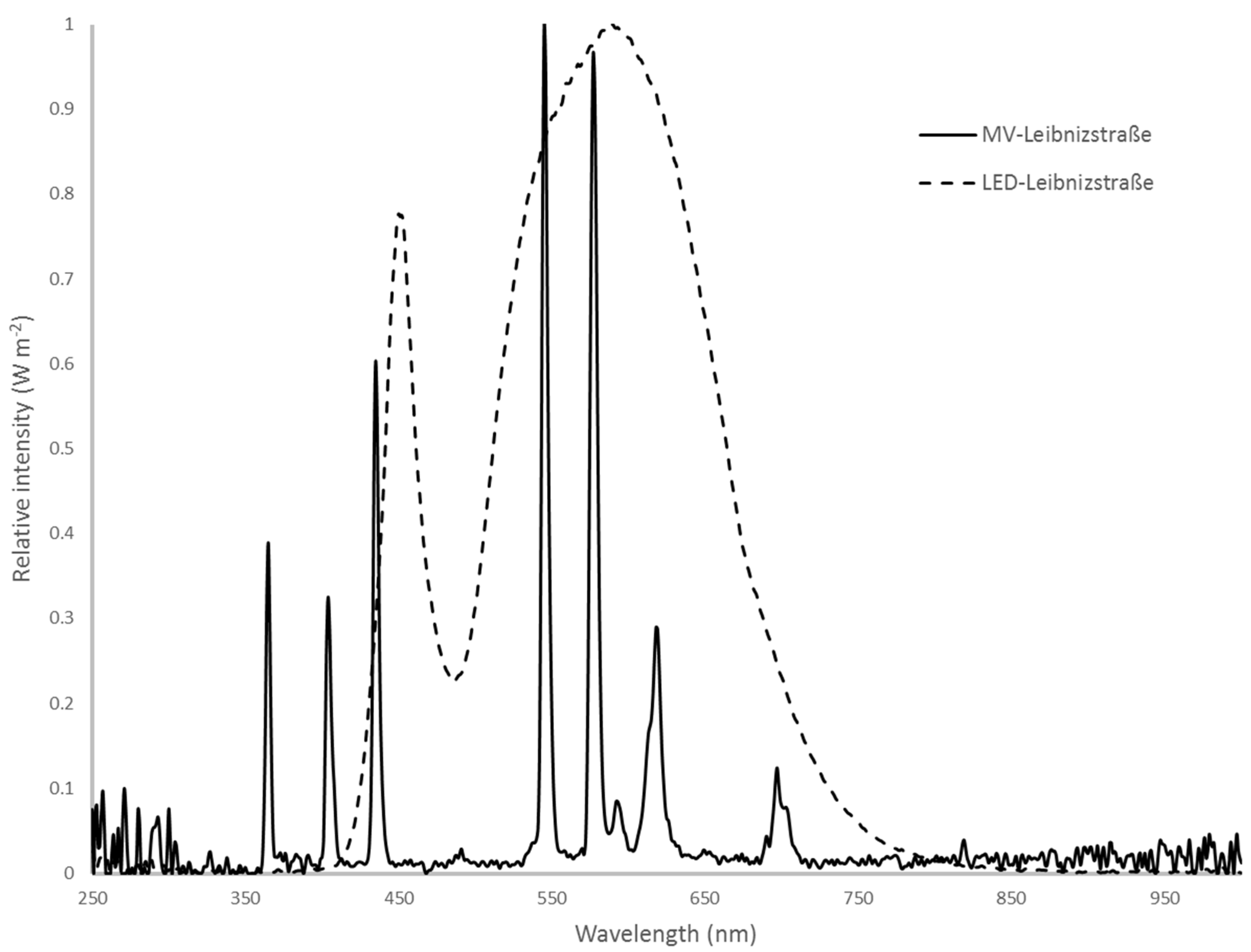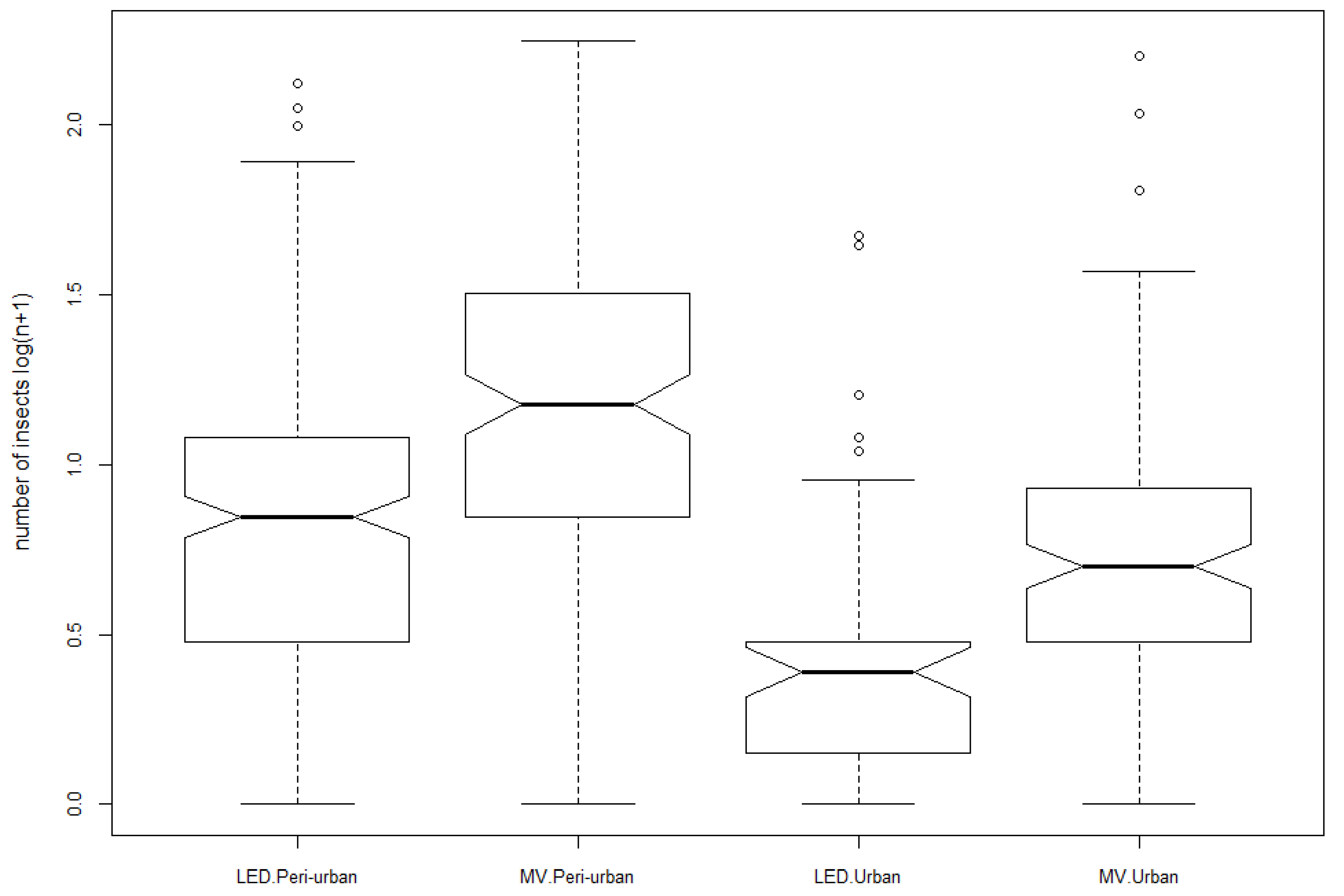Long-Term Comparison of Attraction of Flying Insects to Streetlights after the Transition from Traditional Light Sources to Light-Emitting Diodes in Urban and Peri-Urban Settings
Abstract
1. Introduction
2. Materials and Methods
3. Results
4. Discussion
Supplementary Materials
Author Contributions
Funding
Acknowledgments
Conflicts of Interest
References
- Kyba, C.C.; Kuester, T.; de Miguel, A.S.; Baugh, K.; Jechow, A.; Hölker, F.; Bennie, J.; Elvidge, C.D.; Gaston, K.J.; Guanter, L. Artificially lit surface of Earth at night increasing in radiance and extent. Sci. Adv. 2017, 3, e1701528. [Google Scholar] [CrossRef] [PubMed]
- Hölker, F.; Moss, T.; Griefahn, B.; Kloas, W.; Voigt, C.C.; Henckel, D.; Hänel, A.; Kappeler, P.M.; Völker, S.; Schwope, A.; et al. The dark side of light: A transdisciplinary research agenda for light pollution policy. Ecol. Soc. 2010, 15, 13. [Google Scholar] [CrossRef]
- Grubisic, M.; Van Grunsven, R.; Kyba, C.; Manfrin, A.; Hölker, F. Insect declines and agroecosystems: Does light pollution matter? Ann. Appl. Biol. 2018, 173, 180–189. [Google Scholar] [CrossRef]
- Rich, C.; Longcore, T. Ecological Consequences of Artificial Night Lighting; Island Press: Washington, DC, USA, 2006. [Google Scholar]
- Hölker, F.; Wolter, C.; Perkin, E.K.; Tockner, K. Light pollution as a biodiversity threat. Trends Ecol. Evol. 2010, 25, 681–682. [Google Scholar] [CrossRef] [PubMed]
- Eisenbeis, G.; Hassel, F. Zur Anziehung nachtaktiver Insekten durch Straßenlaternen–eine Studie kommunaler Beleuchtungseinrichtungen in der Agrarlandschaft Rheinhessens. Nat. Landsch. 2000, 75, 145–156. [Google Scholar]
- Hallmann, C.A.; Sorg, M.; Jongejans, E.; Siepel, H.; Hofland, N.; Schwan, H.; Stenmans, W.; Müller, A.; Sumser, H.; Hörren, T. More than 75 percent decline over 27 years in total flying insect biomass in protected areas. PLoS ONE 2017, 12, e0185809. [Google Scholar] [CrossRef]
- Van Grunsven, R.H.A.; Donners, M.; Boekee, K.; Tichelaar, I.; van Geffen, K.G.; Groenendijk, D.; Berendse, F.; Veenendaal, E.M. Spectral composition of light sources and insect phototaxis, with an evaluation of existing spectral response models. J. Insect. Conserv. 2014, 18, 225–231. [Google Scholar] [CrossRef]
- Van Langevelde, F.; Ettema, J.A.; Donners, M.; WallisDeVries, M.F.; Groenendijk, D. Effect of spectral composition of artificial light on the attraction of moths. Biol. Conserv. 2011, 144, 2274–2281. [Google Scholar] [CrossRef]
- Donners, M.; van Grunsven, R.H.; Groenendijk, D.; van Langevelde, F.; Bikker, J.W.; Longcore, T.; Veenendaal, E. Colors of attraction: Modeling insect flight to light behavior. J. Exp. Zool. A 2018, 329, 434–440. [Google Scholar] [CrossRef]
- Longcore, T.; Aldern, H.L.; Eggers, J.F.; Flores, S.; Franco, L.; Hirshfield-Yamanishi, E.; Petrinec, L.N.; Yan, W.A.; Barroso, A.M. Tuning the white light spectrum of light emitting diode lamps to reduce attraction of nocturnal arthropods. Phil. Trans. R. Soc. B 2015, 370, 20140125. [Google Scholar] [CrossRef]
- Somers-Yeates, R.; Hodgson, D.; McGregor, P.K.; Spalding, A.; Ffrench-Constant, R.H. Shedding light on moths: Shorter wavelengths attract noctuids more than geometrids. Biol. Lett. 2013, 9, 20130376. [Google Scholar] [CrossRef] [PubMed]
- Briscoe, A.D.; Chittka, L. The evolution of color vision in insects. Ann. Rev. Entomol. 2003, 46, 471–510. [Google Scholar] [CrossRef] [PubMed]
- Butler, R. The identification and mapping of spectral cell types in the retina of Periplaneta americana. J. Comp. Physiol. A 1971, 72, 67–80. [Google Scholar] [CrossRef]
- Wakefield, A.; Broyles, M.; Stone, E.L.; Harris, S.; Jones, G. Quantifying the attractiveness of broad-spectrum street lights to aerial nocturnal insects. J. Appl. Ecol. 2018, 55, 714–722. [Google Scholar] [CrossRef]
- Manfrin, A.; Singer, G.; Larsen, S.; Weiss, N.; van Grunsven, R.H.; Weiss, N.-S.; Wohlfahrt, S.; Monaghan, M.T.; Hölker, F. Artificial light at night affects organism flux across ecosystem boundaries and drives community structure in the recipient ecosystem. Front. Environ. Sci. 2017, 5, 61. [Google Scholar] [CrossRef]
- Altermatt, F.; Ebert, D. Reduced flight-to-light behaviour of moth populations exposed to long-term urban light pollution. Biol. Lett. 2016, 12, 20160111. [Google Scholar] [CrossRef] [PubMed]
- Donatello, S.; Rodríguez, R.; Quintero, M.G.C.; JRC, O.W.; Van Tichelen, P.; Van, V.; Hoof, T.G.V. Revision of the EU Green Public Procurement Criteria for Road Lighting and Traffic Signals. Publications Office of the European Union: Luxembourg, 2019. Available online: https://ec.europa.eu/jrc/en/publication/revision-eu-green-public-procurement-criteria-road-lighting-and-traffic-signals (accessed on 6 November 2019).
- Van Grunsven, R.H.; Jähnichen, D.; Grubisic, M.; Hölker, F. Slugs (Arionidae) benefit from nocturnal artificial illumination. J. Exp. Zool. A 2018, 329, 429–433. [Google Scholar] [CrossRef]
- Sanders, D.; Kehoe, R.; Tiley, K.; Bennie, J.; Cruse, D.; Davies, T.W.; Van Veen, F.F.; Gaston, K.J. Artificial nighttime light changes aphid-parasitoid population dynamics. Sci. Rep. 2015, 5, 15232. [Google Scholar] [CrossRef]
- Durrant, J.; Michaelides, E.B.; Rupasinghe, T.; Tull, D.; Green, M.P.; Jones, T.M. Constant illumination reduces circulating melatonin and impairs immune function in the cricket Teleogryllus commodus. PeerJ 2015, 3, e1075. [Google Scholar] [CrossRef]
- Svensson, A.; Rydell, J. Mercury vapour lamps interfere with the bat defence of tympanate moths (Operophtera spp. Geometridae). Anim. Behav. 1998, 55, 223–226. [Google Scholar] [CrossRef][Green Version]
- Bennie, J.; Davies, T.W.; Cruse, D.; Bell, F.; Gaston, K.J. Artificial light at night alters grassland vegetation species composition and phenology. J. Appl. Ecol. 2018, 55, 442–450. [Google Scholar] [CrossRef]
- Schroer, S.; Häffner, E.; Hölker, F. Impact of artificial illumination on the development of a leafmining moth in urban trees. Intern. J. Sust. Light. 2019, 21, 1–10. [Google Scholar] [CrossRef]
- Van Geffen, K.G.; Groot, A.T.; van Grunsven, R.H.A.; Donners, M.; Berendse, F.; Veenendaal, E.M. Artificial night lighting disrupts sex pheromone in a noctuid moth. Ecol. Entomol. 2015, 40, 401–408. [Google Scholar] [CrossRef]
- Van Geffen, K.G.; Eck, E.; Boer, R.A.; van Grunsven, R.H.A.; Salis, L.; Berendse, F.; Veenendaal, E.M. Artificial light at night inhibits mating in a Geometrid moth. Insect Conserv. Divers. 2015, 8, 282–287. [Google Scholar] [CrossRef]
- Van Langevelde, F.; van Grunsven, R.H.A.; Veenendaal, E.M.; Fijen, T.P.M. Artificial night lighting inhibits feeding in moths. Biol. Lett. 2017, 13, 20160874. [Google Scholar] [CrossRef]
- Longcore, T.; Rodríguez, A.; Witherington, B.; Penniman, J.F.; Herf, L.; Herf, M. Rapid assessment of lamp spectrum to quantify ecological effects of light at night. J. Exp. Zool. A 2018, 329, 511–521. [Google Scholar] [CrossRef] [PubMed]
- Van Geffen, K.G.; van Grunsven, R.H.A.; van Ruijven, J.; Berendse, F.; Veenendaal, E.M. Artificial light at night causes diapause inhibition and sex-specific life history changes in a moth. Ecol. Evol. 2014, 4, 2082–2089. [Google Scholar] [CrossRef]
- Macgregor, C.J.; Evans, D.M.; Fox, R.; Pocock, M.J. The dark side of street lighting: Impacts on moths and evidence for the disruption of nocturnal pollen transport. Glob. Chang. Biol. 2017, 23, 697–707. [Google Scholar] [CrossRef]
- Knop, E.; Zoller, L.; Ryser, R.; Gerpe, C.; Hörler, M.; Fontaine, C. Artificial light at night as a new threat to pollination. Nature 2017, 548, 206–209. [Google Scholar] [CrossRef]
- Lewanzik, D.; Voigt, C.C. Transition from conventional to light-emitting diode street lighting changes activity of urban bats. J. Appl. Ecol. 2016, 54, 264–271. [Google Scholar] [CrossRef]
- Spoelstra, K.; van Grunsven, R.H.; Ramakers, J.J.; Ferguson, K.B.; Raap, T.; Donners, M.; Veenendaal, E.M.; Visser, M.E. Response of bats to light with different spectra: Light-shy and agile bat presence is affected by white and green, but not red light. Proc. R. Soc. B 2017, 284, 20170075. [Google Scholar] [CrossRef] [PubMed]
- Voigt, C.C.; Azam, C.; Dekker, J.; Ferguson, J.; Fritze, M.; Gazaryan, S.; Hölker, F.; Jones, G.; Leader, N.; Lewanzik, D.; et al. Guidelines for Consideration of Bats in Lighting Projects; Technical Report; UN Environment, UNEP/EUROBATS Secretariat: Bonn, Germany, 2018. [Google Scholar]
- Eisenbeis, G. Artificial night lighting and insects: Attraction of insects to streetlamps in a rural setting in Germany. In Ecological Consequences of Artificial Night Lighting; Rich, C., Longcore, T., Eds.; Island Press: Washington, DC, USA, 2006. [Google Scholar]
- Plummer, K.E.; Hale, J.D.; O’Callaghan, M.J.; Sadler, J.P.; Siriwardena, G.M. Investigating the impact of street lighting changes on garden moth communities. J. Urb. Ecol. 2016, 2, juw004. [Google Scholar] [CrossRef]
- Degen, T.; Mitesser, O.; Perkin, E.K.; Weiß, N.S.; Oehlert, M.; Mattig, E.; Hölker, F. Street lighting: Sex-independent impacts on moth movement. J. Anim. Ecol. 2016, 85, 1352–1360. [Google Scholar] [CrossRef]
- Van Grunsven, R.H.A.; Lham, D.; van Geffen, K.G.; Veenendaal, E.M. Range of attraction of a 6-W moth light trap. Entomol. Exp. Appl. 2014, 152, 87–90. [Google Scholar] [CrossRef]


| Location | Light Source | Year | Sample-Events |
|---|---|---|---|
| Urban (Berlin city center) | |||
| Leibnizstraße north | MV | 2011 | 44 |
| Leibnizstraße south | MV | 2011 | 44 |
| Leibnizstraße north | MV | 2012 | 56 |
| Leibnizstraße south | LED | 2012 | 56 |
| Peri-urban (Schulzendorf) | |||
| Jahnstraße | MV | 2011 | 112 |
| Jahnstraße | MV | 2012 | 60 |
| Jahnstraße | LED | 2012 | 60 |
| Brandenburger Straße | LED | 2012 | 60 |
| Brandenburger Straße | LED | 2013 | 39 |
| Helgolandstraße | LED | 2013 | 33 |
| Jahnstraße | LED | 2013 | 73 |
| Location | Light Source | Mean Illuminance (lx) | Mean Correlated Color Temperature (k) | Mean Height (m) |
|---|---|---|---|---|
| Urban (city center Berlin) | ||||
| Leibnizstraße north | MV | 9.6 | 4290 | 10.0 |
| Leibnizstraße south | MV | 9.1 | 3700 | 10.2 |
| Leibnizstraße south | LED | 9.5 | 3650 | 10.2 |
| Peri-urban (Schulzendorf) | ||||
| Jahnstraße | MV | 10.2 | 4650 | 4.1 |
| Jahnstraße | LED | 18.6 | 4036 | 4.1 |
| Brandenburger Straße | LED | 17.5 | 3360 | 4.9 |
| Helgolandstraße | LED | 7.2 | 2990 | 4.4 |
© 2019 by the authors. Licensee MDPI, Basel, Switzerland. This article is an open access article distributed under the terms and conditions of the Creative Commons Attribution (CC BY) license (http://creativecommons.org/licenses/by/4.0/).
Share and Cite
van Grunsven, R.H.A.; Becker, J.; Peter, S.; Heller, S.; Hölker, F. Long-Term Comparison of Attraction of Flying Insects to Streetlights after the Transition from Traditional Light Sources to Light-Emitting Diodes in Urban and Peri-Urban Settings. Sustainability 2019, 11, 6198. https://doi.org/10.3390/su11226198
van Grunsven RHA, Becker J, Peter S, Heller S, Hölker F. Long-Term Comparison of Attraction of Flying Insects to Streetlights after the Transition from Traditional Light Sources to Light-Emitting Diodes in Urban and Peri-Urban Settings. Sustainability. 2019; 11(22):6198. https://doi.org/10.3390/su11226198
Chicago/Turabian Stylevan Grunsven, Roy H. A., Julia Becker, Stephanie Peter, Stefan Heller, and Franz Hölker. 2019. "Long-Term Comparison of Attraction of Flying Insects to Streetlights after the Transition from Traditional Light Sources to Light-Emitting Diodes in Urban and Peri-Urban Settings" Sustainability 11, no. 22: 6198. https://doi.org/10.3390/su11226198
APA Stylevan Grunsven, R. H. A., Becker, J., Peter, S., Heller, S., & Hölker, F. (2019). Long-Term Comparison of Attraction of Flying Insects to Streetlights after the Transition from Traditional Light Sources to Light-Emitting Diodes in Urban and Peri-Urban Settings. Sustainability, 11(22), 6198. https://doi.org/10.3390/su11226198





